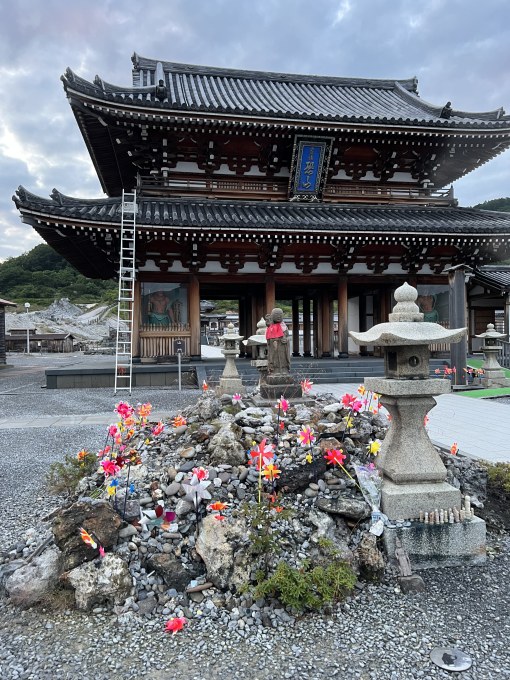
As you may have already known, most Japanese are Buddhists and they also have long and deep relationship with Buddhist temples in their neighborhood, because they usually hold most of their Buddhist memorial services such as funerals, Bon festivals, vernal and autumnal equinox festivals, in collaboration with the temples.
This time I’d like to talk about shakyo(写経), one of the practices of learning Buddhism and its scripture in a easy way.
Shakyo is an easy way of learning Japanese Buddhism
As they often have deep relationships with Buddhism, not a few Japanese people are willing to visit the Buddhist temples to learn Buddhism doctrine and the meaning of its scripture.
They can sometimes listen to lectures given by the temples’ monks about Buddhism.

Toji'(東寺), one of Kyoto’s most famous and largest Buddhist temples, belonging to Shingon sect(真言宗). Although Toji is Kanji(かんじ:官寺), or a Buddhist temple sponsored and founded by Japanese government many centuries ago in the hope of the country’s peace and security, and so it’s not directly related to people in the neighborhood, but it does for sure represent the significant and solemn atmosphere unique to other Buddhist temples in Japan.
In addition to that, whoever visiting some Buddhist temples can experience the only atmosphere of the depth and dignity of Buddhism in a way.
That’s shakyo(写経), learning Buddhism by copying Buddhist scripture by hand, mainly at Buddhist temples.

In Ninnaji(仁和寺) ,Northern West of Kyoto, there is a room for shakyo and everyone can easily copy Hannyashingyo(般若心経) sutra with a calligraphy brush prepared there.
The picture was taken when I visited the temple and tried copying Hannyashingyo sutra in the shakyo room on a winter’s day.
Do we have to have learned or understood Buddhism doctrine before doing shakyo? Or do we have to learn it while joining it?
To tell the truth, it’s desirable you learn Buddhism doctrine if not perfectly during the practice or in advance. But actually, it’s not necessarily a must, because the doctrine is often too difficult and deep even for us Japanese to understand.
As a result, not a few Japanese who are enthusiastic about shakyo and visiting their related temples often have little idea about the exact meaning of the sutra they copying in shakyo.

This is Hannyashingyo(般若心経), one of the most important Buddhist sutras.
I tried hard to finish copying it at Ninnaji, but, to be honest, I have little idea of its meaning: it’s certainly too difficult for me to understand.
Even Buddhist monks can hardly realize it and only a few of them, most of whom are high-class dignitaries, seem to be able to teach others.
Only Buddhists can join the practice?
It seems not so. Generally speaking, Japanese people have a unique thought of religion from a global standpoint: they(we) basically receive any religion and assimilate different religions into their events, their life, and their thought.
As its proof, you may have already seen in Japan many of them join and enjoy Christmas, Halloween, along with their traditional visit to Shinto shrines especially on new year’s days, and various Buddhist ceremonies.
In this regard, however, we can conversely say this way, “Those who believe in foreign religion can join Buddhism events and ceremonies”, at least in Japan, right?
So I guess most Buddhist temples in Japan won’t refuse to be joined by foreign people and tourists who believe in other religions than Buddhism.
If you want to know the exact details about the matter, you should contact the temples you want to visit by e-mail or by (smart)phone.
Only parishioners can join shakyo practice at any temple?
I think it depends on each temple.
Here, you should know “Danka”.
In Buddhism, the word parishioner means “Danka(檀家)”, supporters of a temple, who usually live in the same region as the temple and hold their various Buddhist ceremonies in collaboration with it.

I join shakyo event at my local temple about once a month.
I usually have a hard time get accustomed to Mohitsu(Japanese calligraphy brush) in copying Buddhism scripture: including me, most Japanese seldom use Mohitsu.
As for me, I sometimes join shakyo events at a temple in my neighborhood, but most of other participants are living in the same neighborhood and there doesn’t seem no one from other regions, let alone foreigners.
In fact, such small temples can hardly prepare for foreigners and foreign tourists who cannot understand Japanese and its letters.

Shakyo room in Ninnaji. You can copy Buddhism scripture with calligraphy brush(prepared) in a relaxing atmosphere.
However, take Ninnaji above. There you will find anyone who visits the temple can experience shakyo!

In my opinion, although smaller temples can only receive people living in the same neighborhood, large and famous temple can receive all the people, even who are from foreign countries.
You should contact the temple before visiting it, anyway.
And it’s also important for you to think over about the religion you believe in now: I mean whether joining shakyo will be problem or not for your religion.
Furthermore, if you’re interested in shakyo, please seek for more information. Surf the internet. Search for or contact temples like Ninaji, receiving foreigners for shakyo. Or seeking the internet or books for the exact meaning of Buddhism scripture will also be meaningful!



